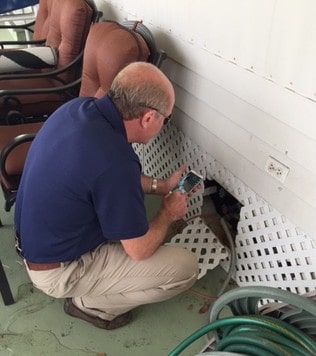Mobile Home Inspections…
identifying potential problems
before you buy.
Manufactured and Mobile Home Inspections
Inspecting the Undercarriage, Tie downs and Vapor Barriers are very important for a Mobile home.


The undercarriage inspection includes:
- Checking for loose straps since straps should be tight and straight.
- Looking for straps and anchors that show signs of corrosion or damage.
- Checking to make sure straps and ground anchors are not damaged or corroded.
- Checking that straps are not kinked or bent, or otherwise abnormally stressed.
- Checking vapor barriers to make sure the barriers are not torn or damaged.
Hope Home Inspections LLC provides professional manufactured and mobile home inspection services in Sarasota, Bradenton, Lakewood Ranch, St. Petersburg, Clearwater and surrounding areas.
Mobile homes receive the same inspection as a standard home inspection. However, with mobile homes we also examine the undercarriage, vapor barrier and the tie downs. These items are very important to inspect because of the high level of moisture and threat of hurricanes here in Florida.
Vapor barriers help reduce the moisture that can seep up through the floor from the ground beneath. These often can become torn and/or detached.
Tie-downs are systems of heavy-duty straps and anchors designed to stabilize manufactured and mobile homes during high winds. Improperly installed or poorly maintained tie-downs could result in reduced capacity to resist sliding and overturning. Manufactured homes are more easily flipped or damaged during windstorms than site-built homes which is why they require tie-downs to remain stable. Additionally, Manufactured homes are elevated and lightweight when compared to site-built homes which makes them vulnerable to wind uplift if they are not equipped with skirting. Wind passing over the top of such homes can exacerbate the effect.
The cost of a manufactured or mobile home inspection is based on the square footage and age of the home. When you book an inspection online you enter in basic information, including the square footage and the year the home was built, and you will see the cost of the inspection. Additionally, you will be able to select the inspection time and date that works best for you. You can also contact our office by phone at 941-773-1144 to receive a quote and/or book your home inspection.
Click here for an example of one of our home inspection reports.
Optional Inspection Services available upon request:
- Lead Based Paint Testing
- Well and Water testing
- 4 Point Insurance Reports
- Docks
- Outbuildings / Separate Structures
- Air Quality / Mold
- VOC Testing
- Sewer Scope
- Termite (WDO)- provided by a 3rd party pest control company
Important Information on Tie-Downs for Manufactured Homes
Two Types of Tie-Downs:
- Over-the-top tie-downs, which are straps that are placed over the siding and roof.
- Some manufactured homes come equipped with concealed over-the-top tie-downs, which are located just under the exterior siding and metal roof. The end of the strap is present under the manufactured home. While this is an effective system, it can detract from the appearance of the home. Single-wide manufactured homes, as they are lightweight, generally require over-the-top tie-downs as well as frame anchors.
- Frame anchors, which are straps that attach to the home’s frame rails.
- Many newer manufactured homes, as they are structurally superior to older models, may be secured solely with frame anchors. Double-wide models are generally heavy enough to resist winds without the aid of over-the-top tie-downs, but they do require frame anchors.
Tie-Down Components:
- Ground anchors are metal rods driven into the ground to secure the tie-down tightly in place.
- A number of different types of ground anchors are available to suit various soil conditions. Auger anchors, for instance, have been designed for use in both hard and soft soil. Rock anchors or drive anchors allow the attachment to a rock or coral base. As only several inches of the anchors will be above the ground, so inspectors will not be able to determine which type is used.
- Hook-up and tension devices work in conjunction with tie-downs.
- The tie-down must be connected to the anchor with a system that allows for the tension to be adjusted. This system must also be weather-resistant and strong enough to support as much weight as the anchor and tie-down. If the tie-down is fastened to a ground anchor with a drop-forged turnbuckle, it should be 1⁄2- inch or larger galvanized steel. The turnbuckle should have forged or welded eyes, and not hook ends, as the tie-down could slip from hook ends.
- Roof protectors are placed under the strap at the edge of the roof for exposed over-the-top tie-downs.
- These prevent the tie-down strap from damaging the roof and will prevent the edge of the roof from cutting through the tie-down.
